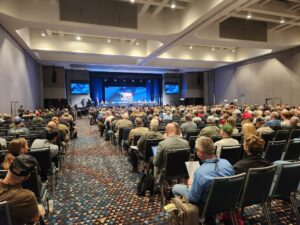As you guys know, I was in Atlanta last weekend covering the NRA’s Annual Meeting. Of course, I wasn’t alone there. The group claims about 70,000 people came through the door over the course of the weekend.
So, I talked to as many of them as I could to get an idea of what they think of the NRA, its current state, and its future. The results are pretty interesting, and a bit different than the last time I interviewed a bunch of folks at an NRA show. Attendees this time around seemed generally more aware of what was going on at the top of the NRA and more focused on the group’s political activities.
While I focused on the NRA’s situation, Contributing Writer Jake Fogleman did a deep dive into the DOJ’s positioning on non-violent felons and their gun rights. As I predicted when the new rights restoration process rolled out, one side effect appears to be that some of the gun-rights movement’s prime Second Amendment cases will be taken off the playing field. And it seems that’s actually the DOJ’s preferred outcome.
Plus, Ohio State University accounting professor Briand Mittendorf breaks down the latest NRA financial report on the podcast.

What People at the NRA Annual Meeting Want to See From the Gun Group [Member Exclusive]
By Stephen Gutowski
Atlanta, Georgia — The National Rifle Association’s CEO, Doug Hamlin, estimated upwards of 70,000 people showed up to the group’s conference last weekend. The Reload spoke to a dozen or so while they perused the cavernous exhibit floor of the Georgia World Congress Center, which was packed with the latest firearms and accessories the industry has to offer.
The nation’s largest gun-rights group has been battered by a half-decade-long corruption scandal, stemming from now-former CEO Wayne LaPierre’s misallocation of millions in NRA funds toward lavish personal expenses. It’s lost millions of members, seen its revenues cut nearly in half, and lost political capital along the way. But its corruption trial is now over, and reformers have taken control of its leadership positions by promising increased transparency and accountability–something that struck a chord with those on the exhibit floor.
“I love the new blood that’s coming into it and all that stuff,” Stephen Stinchcomb of Flowery Branch, Georgia, who has been an NRA member for about eight years, said about the reformers. “The old order is kind of getting out of the way, and the new guys are coming in. You’ve got fresh ideas.”
Scott, a 30-year member from Chattanooga, Tennessee, said he liked the new faces and voices leading the NRA.
“I do think, at the very top levels, very much the same way as we have in Congress, and the nation in general, it’s time for some new blood,” he said.
Joel Moore, from Houston, Texas, has only been a member for a few years. But he agreed.
“I’m feeling very good, very comfortable with it,” he told The Reload. “They’re on the right track.”
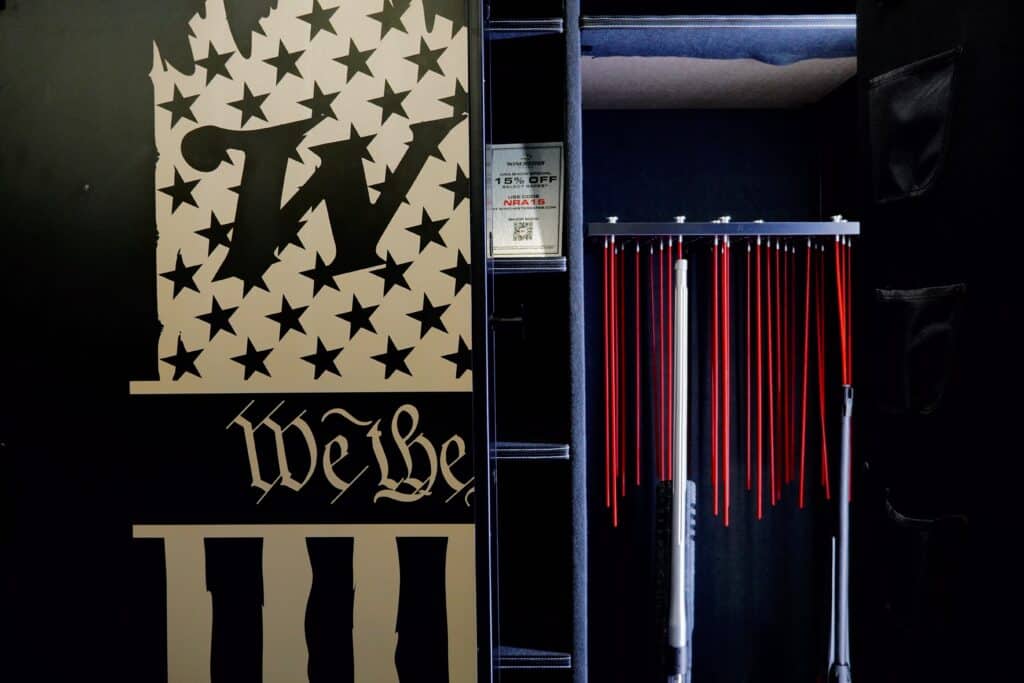
Not everyone is completely satisfied with the turnover in leadership or the reforms the group has implemented to this point.
Ronald Andring has been an NRA member off and on for decades, but has taken a closer interest in the group over the last decade. He’s the only member who independently wrote to the judge overseeing the group’s corruption trial and, later, testified in it. He said the misuse of member dues has pushed him into a years-long campaign to bring about reforms inside the gun group.
He introduced several resolutions during the Members’ Meeting on Saturday. One of them, an effort to get the NRA to adopt a much stricter conflict-of-interest policy, was sent to the board for further deliberation, but with the added recommendation that Andring be added to the committee considering it. He told The Reload he’s far from satisfied but believes the tide is turning.
“In the last couple of years, because of the members finally waking up and deciding to elect people to the board, besides the old guard that has populated the board and populated the committees for all these last 25 years, or whatever,” he said. “What you now have is a movement in the board that hasn’t existed for a while.”
Scott from Chattanooga said he found the LaPierre scandal “disturbing” and argued it was emblematic of larger problems in American society.
“The whole country is tired, they’re tired of people getting involved with either not-for-profits or the government or whatever, enriching themselves,” he told The Reload. “The NRA needs to become very mission-focused. It risks becoming irrelevant.”
He argued the NRA needs to do everything it can to show people it isn’t compromised because he believes its mission is too important to risk turning people off.
“It’s important that organizations like this, who are really trying to fight and preserve sacred parts of the heritage of the country, really clean up their act and show, you know, ‘listen, we’re good people,'” he said. “I think that’s really the big thing to me. There’s a real push for that, a push for transparency, a push to not waste money. I think the people are tired, they’re worn out, and they feel like there’s a group of people who are getting rich while they’re having a hard time making ends meet. And double-digit inflation just made that more dramatic, easier to see, because I can’t afford to buy eggs, but you’re taking private jets?”
Scott said the NRA should do whatever it takes to shore up its credibility.
“Anytime the media and the people who are anti gun folks have an opportunity to find some chink in the armor, ‘Oh, well, look at you. You’re a hypocrite because you do this, you’re a hypocrite because you spent that,'” he said. “You know, it’s imperative that organizations like this try to become as above reproach as possible. And if that means extra audits, if that means increased transparency, if that means more turnover, fresh faces, it’s time to do that.”
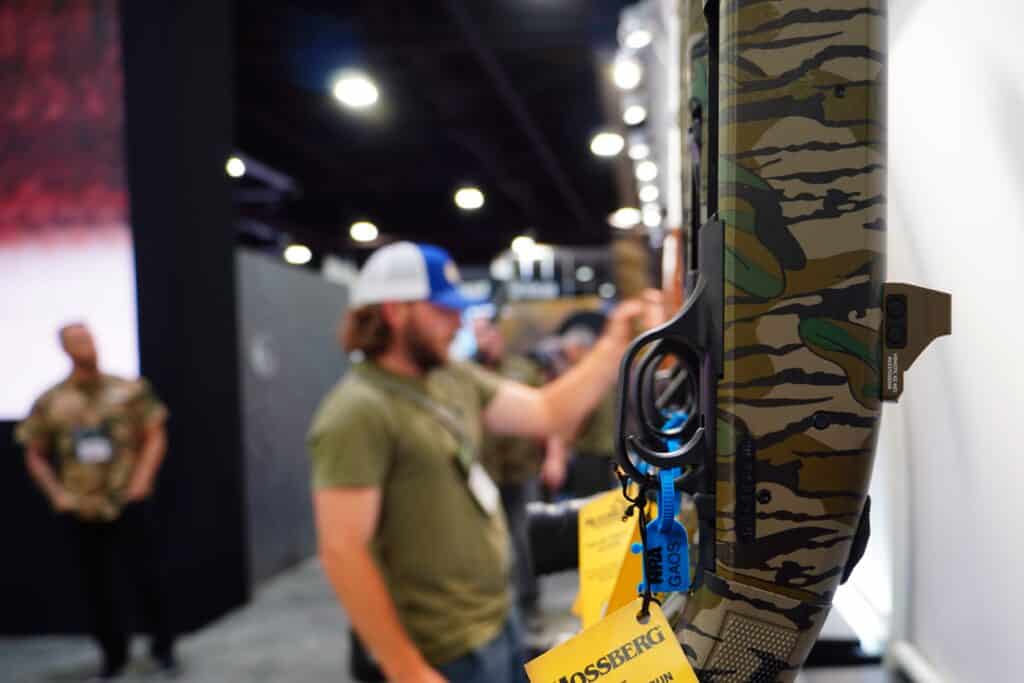
Travis from Georgia has been a member since just about the time the LaPierre scandal broke into public view. But he said his view of the group is pretty simple.
“I’m pretty happy with how things are going,” he said. “I like the fact that they stand for the Second Amendment.”
That view wasn’t uncommon on the exhibit floor either. Most of the NRA members who spoke to The Reload said their primary reason for joining was to support the group’s mission of protecting gun rights.
Gerald Fuller has been a member since the 1990s. The North Carolinian said he hasn’t followed the NRA’s corruption scandal very closely, but, while he does think the group could be a better steward of members’ money, he isn’t going to leave anytime soon.
“I think it’s a good organization. They just need to work out a few quirks, but that’s every organization,” he told The Reload. There’s always room for change, room for improvement on everything.”
Jason Lock, a competitive shooter who traveled from Nashville to explore the exhibit floor, had a similar view.
“I feel like any organization that puts their efforts towards supporting the Second Amendment is worth my support,” Lock, who has been an NRA member off and on for a decade, said. “The internal politics of what goes on inside those organizations doesn’t really affect whether I have membership or not. When the people who call and ask me to renew my membership and say, ‘you can get three or four years for a discounted rate,’ I always refuse, because I want to pay the full amount for each year so that all my dollars can go to helping preserve the Second Amendment.”
Fuller’s advice for the group is to “step up and fight harder for our Second Amendment rights.” That was a pretty common refrain as well.
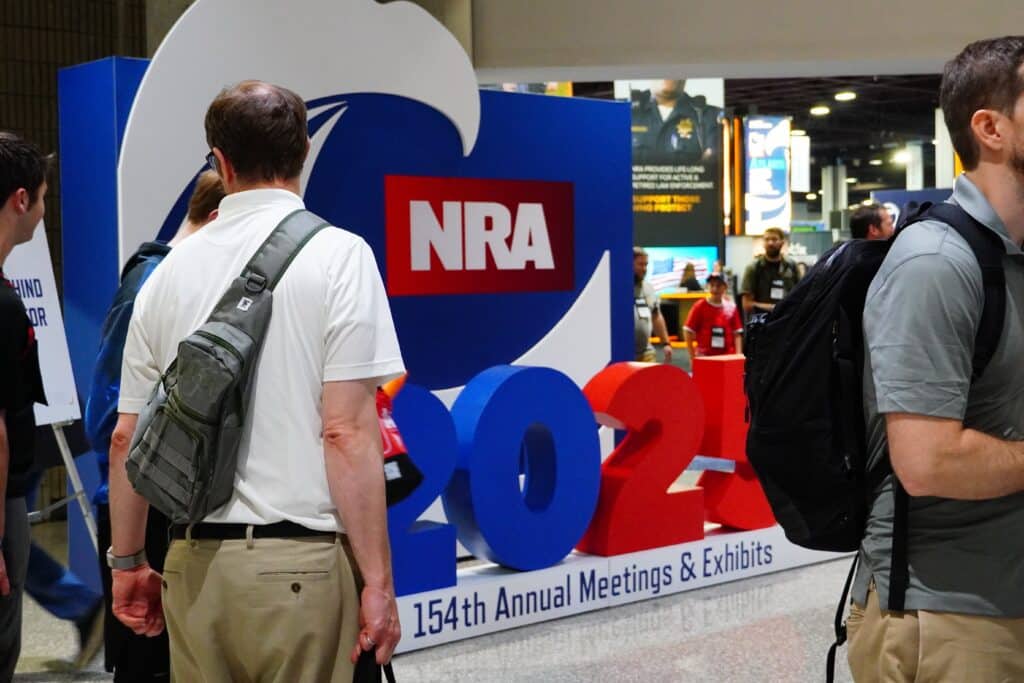
“I think they will always have to maintain a pretty strong presence, because there’s just a force that continues to want to remove a well-armed militia,” Moore said. “And it’s not a radical thought. It’s just a feeling that I’d rather be in the position to be armed than not.”
“I know they have a big focus on the Second Amendment. So, I like that a lot,” Stinchcomb said. “But I’d like to see them fight more for suppressor deregulation and stuff like that.”
Transparency and a renewed focus on political advocacy weren’t the only things the attendees who spoke with The Reload were hoping to see, though. While the NRA’s finances continued to slide throughout 2024, the slope of that slide was less extreme, and the end of the corruption trial has freed up tens of millions of dollars the group can put toward other uses. Lock said he was excited about one of the group’s new initiatives.
“The NRA came out with a new competition that was two-gun and three-gun,” he said. “Think it’s an AR competition, and that is really interesting to me. I think it’s good for getting more people into it, especially because they may not come shoot three-gun like I shoot. They may not shoot USPSA, but they know about the NRA. So, they may come and bring their black guns and play some competition with us. So, I’m happy to see them doing that. I’m happy to see them opening that up.”
“If they’re kind of dabbling in that, then that kind of lets me know that they think about the other genres besides just defensive shooting,” he added. “There are many ways to use our firearms, and we need to protect that.”

Of course, the Annual Meeting is open to the general public. You don’t have to be an NRA member to get in. So, there were plenty of people who’d either never joined or let their membership lapse for one reason or another.
Hunter and Carrie Anne, a pair of military servicemembers from Louisiana, drove up from Fort Benning to attend the show. It was the first one for both of them. She was offered a job modeling for Curves N’ Combatboots, which makes leggings with integrated fabric holsters. He came along to see what the show was all about.
“I haven’t really paid much attention or heard much about it until today,” Hunter said of the NRA show. “But it’s been really great. I was just telling her, I feel like you have to come in here knowing what you want, because there’s so much stuff in here. It’s so cool, but it’s good to see all the booths and to explore and experiment and actually hold the weapons and stuff so you have an idea of what you want.”
“People are really friendly, too,” Carrie Anne said.
“It’s been a really good experience,” Hunter added.
They said they’d definitely be back when the NRA returns to Atlanta again in a few years, and they planned to look into becoming members in the meantime.
Eric, a young man from Atlanta with a master’s degree and an indie-rock style, said he wasn’t a member either. Although, he viewed his entrance fee and efforts to introduce new people to the shooting sports as a way of supporting the NRA’s mission. Of course, he also saw the show primarily as a great way to spend a weekend afternoon.
“I love coming to these events, looking at all this, like hanging out with people, chatting, seeing what new technology is coming out, just seeing cool stuff and getting my hands on it,” he said.
He said he planned to come back to the Annual Meeting again and attend other events like it, too. But he wasn’t sold on getting an NRA membership yet, mostly because he felt he wasn’t well enough informed about the group’s internal dynamics or the membership’s benefits to make a commitment like that.
“I’m not gonna join unless I’m just fully educated,” Eric told The Reload. “It’s like, when you go get Netflix, you know what you’re getting, right? When I got HBO Max, I bought that the other day, and I know what I’m getting. When you join a gun club, you know what you get. With the NRA, I haven’t really put the thought into it. I’ll probably become a member way down the road. But if I’m gonna go with that, instead of going to the show, I’d like to go to the legal seminars, go to meetings where they set policies or make decisions. But, you know, that alone sounds like a second job. But the show floor is where all the fun is. It feels like I’m at Six Flags,”
Tommy, an off-duty cop, said he let his NRA membership lapse over the LaPierre corruption scandal and the group’s partial backing of the bumpstock ban during the first Donald Trump administration.
“I just feel like a lot of other organizations, like Gun Owners of America, were doing a better job,” he said.
He said his work on the streets of Atlanta has bolstered his commitment to gun rights. He said he’s seen dangerous criminals let off the hook for serious gun crimes, while people he views as harmless hobbyists have the book thrown at them over offenses that shouldn’t be illegal.
“I deal with a lot of weird stuff, and see a lot of Glock switches and stuff like that,” he said. “And it’s funny how I see some cases not get prosecuted or picked up by the ATF, but I see a guy in New York get screwed over for 50 rounds and an 80 percent frame. I think it’s fucked up, excuse my language.”
But he also said he was impressed by the NRA’s recent reforms and is mulling over whether to join up again.
“I’m thinking about getting a membership again,” Tommy said. “I’m reconsidering it.”
First, though, he wants to see “more advocating for gun rights and kind of turning the table back.”
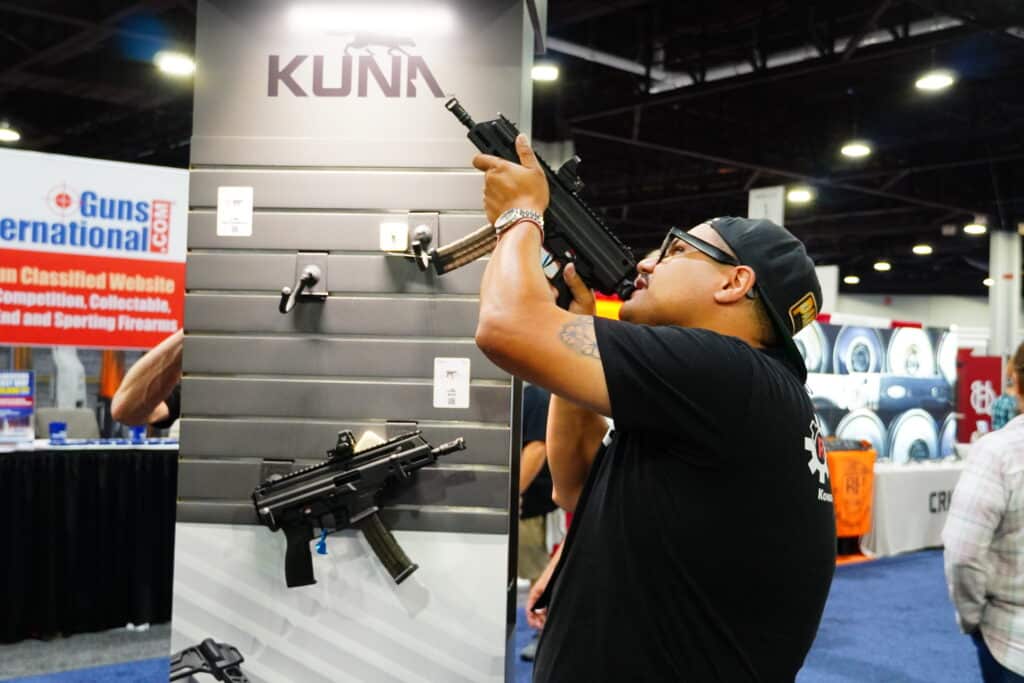
Andring argued the NRA needs to do more than merely change leadership or pass bylaw reforms. He said those steps, while necessary, don’t make up for LaPierre’s misdirection of funds, the money paid to board members, the $200 million spent on Bill Brewer’s legal representation, or other things he views as wrongs.
“You had all of the years of turmoil under Wayne LaPierre,” he said. “As soon as the trial ends, or actually as soon as the bench trial ends, all of a sudden, we launch NRA 2.0 and for all those people who were frustrated, who quit, who were who were upset because their money ended up in the in the pockets of Bill Brewer, or in the pockets of directors and insiders the piece that’s missing is that we are just sort of going to forget the past. And we’re just going to jump into the future. But nobody’s talking about what you say to people who are angry and frustrated to bridge that gap between what was and what you want.”
He said the group needs to admit its missteps to current and former members before it starts trying to ask them to come back on board.
“What they need to be hearing from the NRA is not a solicitation to be joined, not a solicitation to up your membership or whatever, but simply an acknowledgement that they’re not crazy,” Andring said. “They were right to be angry because the NRA Board and the NRA failed them. That was the jury’s verdict. The NRA failed to properly administer the assets of the organization.”
Scott argued the NRA is too important to lose, and too important to let even the appearance of corruption creep in again.
“I think that’s a big thing for any organization, but particularly groups protecting the First Amendment, the Second Amendment, anything that has anything to do with the Bill of Rights. Those organizations have to stay as above reproach as possible,” he said. “They’re taking unfriendly fire, and the last thing they need is friendly fire.”
Podcast: Have the NRA’s Finances Turned a Corner? (ft. OSU Accounting Professor Brian Mittendorf) [Member Early Access]
By Stephen Gutowski
This week, we’re taking a deep dive into the National Rifle Association’s latest financial report.
That’s why we have non-profit expert and Ohio State University accounting professor Brian Mittendorf back on the show. The NRA just had its annual meeting in Atlanta, Georgia, which I was able to attend and pick up copies of the group’s latest annual report. That report shows the membership dues, legal spending, and even conflicts of interest at what remains by far the nation’s largest gun group.
Professor Mittendorf said the numbers showed an organization that’s still in decline, and still racked by legal costs. However, he also said the NRA’s slide is slowing, and there are clear opportunities for them to stabilize or even rebound.
He noted that legal spending, while still sky-high compared to their pre-scandal days, is falling. In fact, the group’s new CEO said legal fees had dropped dramatically from even the time the latest report covers. Mittendorf said that alone could free up tens of millions of dollars, without raising new funds, to put toward the core services the group has cut over the years–something that could pull members back in.
You can listen to the show on your favorite podcasting app or by clicking here. Video of the episode is available on our YouTube channel. An auto-generated transcript is here. Reload Members get access on Sunday, as always. Everyone else can listen on Monday.
Plus, Contributing Writer Jake Fogleman and I discuss a series of legal filings from the Department of Justice urging the Supreme Court not to hear a case on the federal gun ban for non-violent felons. We also look at a brief it filed on the other side of a gun rights issue, urging the Court to overturn a ruling upholding Hawaii’s “sensitive places” restrictions on gun carry. Finally, I recap my time covering the NRA’s annual meeting, where reformers made major gains at the highest levels of the organization.
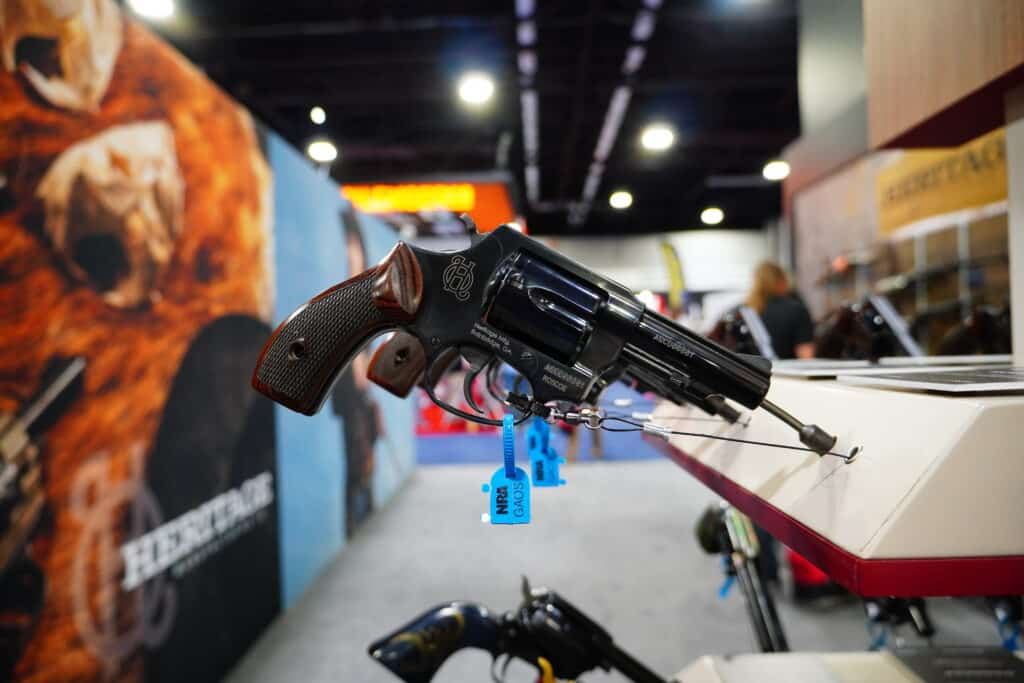
Analysis: The Promise, Pitfalls of the Trump Admin’s Approach to Non-Violent Felon Gun Rights [Member Exclusive]
By Jake Fogleman
The last month has clarified how the Trump Administration plans to approach the gun rights of non-violent felons. Its preferred course offers some benefits but also real downsides for gun-rights advocates.
Back in mid-March, the Department of Justice (DOJ) first unveiled its plan to revive an executive agency process for restoring Second Amendment rights to individuals who are prohibited from possessing firearms. Then, on Monday, the agency released the first results from that action, publishing the names of ten individuals in the Federal Register who now have gun rights again at the determination of Attorney General Pam Bondi.
Between those two actions, however, DOJ was also busy making it clear in legal briefs and letters to Congress that it has no desire to see the question of felon gun rights in the hands of the Supreme Court.
“Although there is some disagreement among the courts of appeals regarding whether Section 922(g)(1) is susceptible to individualized as-applied challenges, that disagreement is shallow,” Solicitor General John Sauer wrote in response to a petition for Supreme Court review last Friday in the case Hunt v. United States. “And any disagreement among the circuits may evaporate given the Department of Justice’s recent reestablishment of the administrative process under 18 U.S.C. 925(c) for granting relief from federal firearms disabilities.”
Likewise, DOJ also opted not to appeal the Third Circuit’s decision in Range v. AG, which struck down the lifetime federal gun ban for convicted felons as applied to the non-violent plaintiff.
The message sent by the moves is clear: the Trump administration is willing to work with Second Amendment supporters on their concerns about the current lifetime disarmament regime, but only to the extent that it complies with the processes outlined in current federal law. The prospect of further limiting the most commonly enforced federal gun statute with a national court ruling, on the other hand, is a bridge too far.
It’s possible that gun-rights advocates might find that to be an acceptable sweet spot. Thanks to the administration’s actions, there is now at least the early makings of the first federal gun rights restoration regime in more than thirty years, one that will be overseen by ostensibly pro-gun personnel.
Assuming the DOJ soon clarifies how the process will work for future applicants, that could mean more opportunities for some felons to regain their rights. It could also happen for far less money than the alternative of having to file costly as-applied lawsuits against the federal ban, and it won’t be subject to the interpretation of federal judges with disparate views. The practical benefits for applicants could be even larger if, as earlier reporting suggested was on the table, the DOJ implements an automated system to streamline rights restoration requests.
Of course, that reliance on reporting to evaluate its upsides is also one of the very real pitfalls of this course of action for gun-rights advocates. To this point, the DOJ has provided almost no concrete details on how applicants will be vetted and selected going forward, which predicate offenses will be prioritized and which will be disqualifying, how much bandwidth the agency has to devote to administering the restorations long-term, and more.
These open questions could become sticking points that limit the new program or even kill it altogether. The fact that one of the first ten people to have their rights restored is Mel Gibson, a celebrity with close ties to the president, doesn’t bode particularly well.
In the meantime, the existence of a new restoration process stands to undermine some of the gun-rights movement’s most promising lawsuits. Judges will likely require even the most sympathetic plaintiffs with the best arguments that the lifetime ban is unconstitutional to first attempt to secure restoration through the DOJ before pursuing a court ruling. That, in turn, risks stunting the momentum they’ve been building in enticing the Supreme Court to address who can be disarmed, and for how long, under friendlier conditions than the last time it did.
In US v. Rahimi, the Court’s most recent Second Amendment decision, a majority of the justices upheld the federal gun ban for those subject to domestic violence restraining orders. They did so, however, in a limited fashion based on the conduct of the respondent in question and the temporary nature of the ban.
“We conclude only this: An individual found by a court to pose a credible threat to the physical safety of another may be temporarily disarmed consistent with the Second Amendment,” Chief Justice John Roberts wrote in the opinion.
By contrast, plaintiffs like Range, or similarly sympathetic plaintiffs, present the exact opposite predicament. Their decades-old, non-violent convictions are not suggestive of any public safety threat. Yet, they are permanently disarmed under the terms of current federal law.
Range himself, who was barred from owning guns after lying to obtain food stamps in the 1990s, will have his gun rights restored because DOJ decided not to appeal his case. But he also won’t have a chance to argue his case at the Supreme Court because of that decision.
It’s possible DOJ may restore the rights of other plaintiffs like Range under its yet-to-be-detailed process. But by removing their claims from the judicial arena, it risks foreclosing the possibility of establishing a more lasting precedent that could impact plaintiffs across the country.
For instance, the bulk of all current Second Amendment challenges to the federal felony gun ban are brought by people who are actively being prosecuted for unlawful possession of a firearm. Assuming their conduct was otherwise non-violent, they would stand to benefit far more from a Supreme Court ruling against portions of the federal ban–even if the ruling was in an as-applied case–than from the DOJ’s post-conviction restoration process.
Lasting precedent also matters because the staying power of the DOJ’s new process, assuming it scales up in earnest, is not guaranteed.
The original iteration of the federal rights restoration process proved controversial enough that Congress opted to defund it entirely in 1992. Left in its current, uncodified state, the renewed version housed under the Attorney General could similarly be discarded by a subsequent administration.
Overall, it’s clear that the Trump team believes their new regulatory rights-restoration process will be enough to assuage Second Amendment supporters’ concerns with the current lifetime disarmament regime they’ve been fighting in court. But it’s not clear how broad that process will be. It’s also difficult to see it having as great of an impact as a Supreme Court victory on the same question, which The Court seemed positioned to hand down.
That’s it for now.
I’ll talk to you all again soon.
Thank you,
Stephen Gutowski
Founder
The Reload




